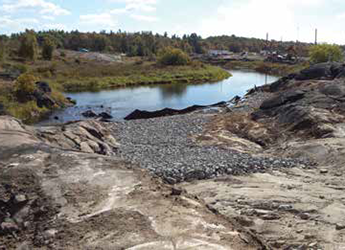
An award-winning mine area clean-up
Mike Edwards
Features Consulting Engineers of Ontario Deloro Mine Site Cleanup Project
Deloro Mine Site Cleanup Project About 60 kilometres east of Peterborough, Ontario, sits a 202-acre abandoned mine and industrial area. Located in Deloro, there is a tiny community of about 160, and a contaminated site with arsenic, cobalt, copper, nickel, low-level radioactive waste and other materials from historical mining and processing activities.
Originally developed to extract and process arsenopyrite ore for the extraction of gold, the site operated as a smelting and refining facility until 1960. In 1979, care and control of the site was undertaken by the Province after it was abandoned by its owners.
The contamination has caused significant environmental impact at the site to things like the site’s soil, sediment, surface water and groundwater. It was also a threat to nearby communities and watercourses.
The Ontario Ministry of the Environment and Climate Change (MOECC) undertook a project to clean up the site by isolating and containing waste and engineering it to be safe for people and the environment for hundreds of years.
McIntosh Perry Consulting Engineers Ltd. was the prime consultant providing project management, design, contract administration and inspection services for the Deloro Mine Site Cleanup Project. Mark Priddle served as the senior reviewer on the project and says this project was unusual for a number of reasons. While most mine sites are remote or close to homes, this one was both.
As well, there were far more stakeholders involved in this project than one would normally expect. Besides MOECC, some of the others were the Ontario Ministry of Natural Resources and Forestry, the Ontario Ministry of Tourism, Culture and Sport, and environmental groups such as the Lake Ontario Waterkeeper.
As part of the cleanup efforts, taking waste off site wasn’t an option. “With the possibility of radioactive contamination, a lot of arsenic and other materials, the agencies, MOECC and the Canadian Nuclear Safety Commission, weren’t comfortable removing materials off site for disposal at an existing waste site, so a waste-nuclear site licence was issued. This allows for management of radioactive waste so there were certain requirements for building this landfill,” says Priddle. The site is closed, meaning it doesn’t accept waste from outside.
The cleanup plan included constructing two large engineered covers to contain tailings and one engineered containment cell for the collection of excavated contaminated material. It also included measures to direct rain, melting snow and groundwater from the containment areas to keep water from leaching the contaminated material.
As well, water is pumped to an arsenic treatment plant. The clean water then goes into the Moira River. “There was contaminated material right up to the edge of the Moira River and that was all removed. The banks of the Moira River were secured with clean fill to prevent erosion and any further migration of material,” says Priddle.
In 2015, the system prevented nearly 2.5 tonnes of arsenic from going into the Moira River. Arsenic loadings to the river are down by 80 per cent and will continue to drop now that the tailings area and industrial area have been amended.
One of the key differences between the Deloro project and conventional engineered remediation projects is the exceptionally long design life. The engineered liners, waste containment cell, stormwater management measures, groundwater interception and collection features were all designed for a service life of at least 500 years. Besides the chemical contaminants, the low-level radioactive waste at Deloro presents a persistent threat to human health and the environment. It must be electively managed in the long term to protect the site for future generations.
The clean-up leaves a beautiful site with a service life of at least 500 years. It no longer looks like an abandoned mine site, nor does it look like a landfill. “It looks like a beautiful, rolling drumlin,” says Priddle.
The project was recognized by the Consulting Engineers of Ontario with the Willis Chapman Award for 2018 at the Ontario Consulting Engineering Awards.
Print this page